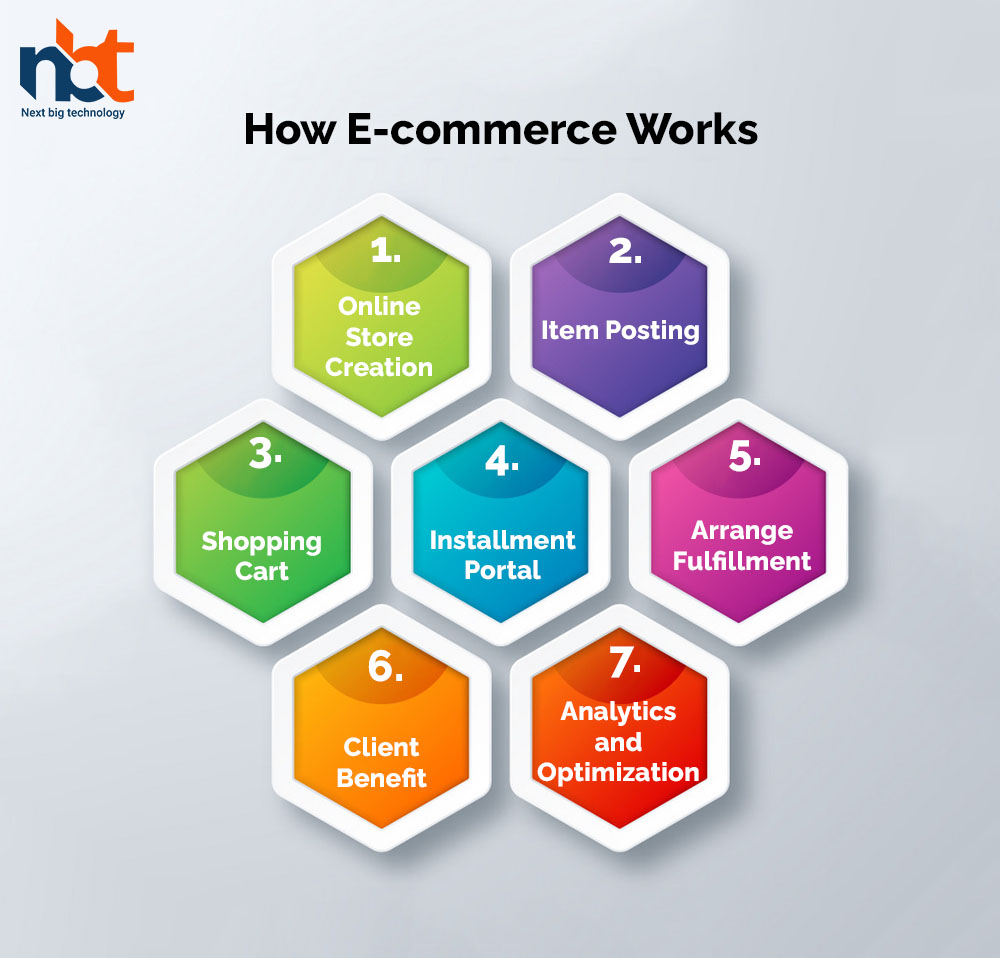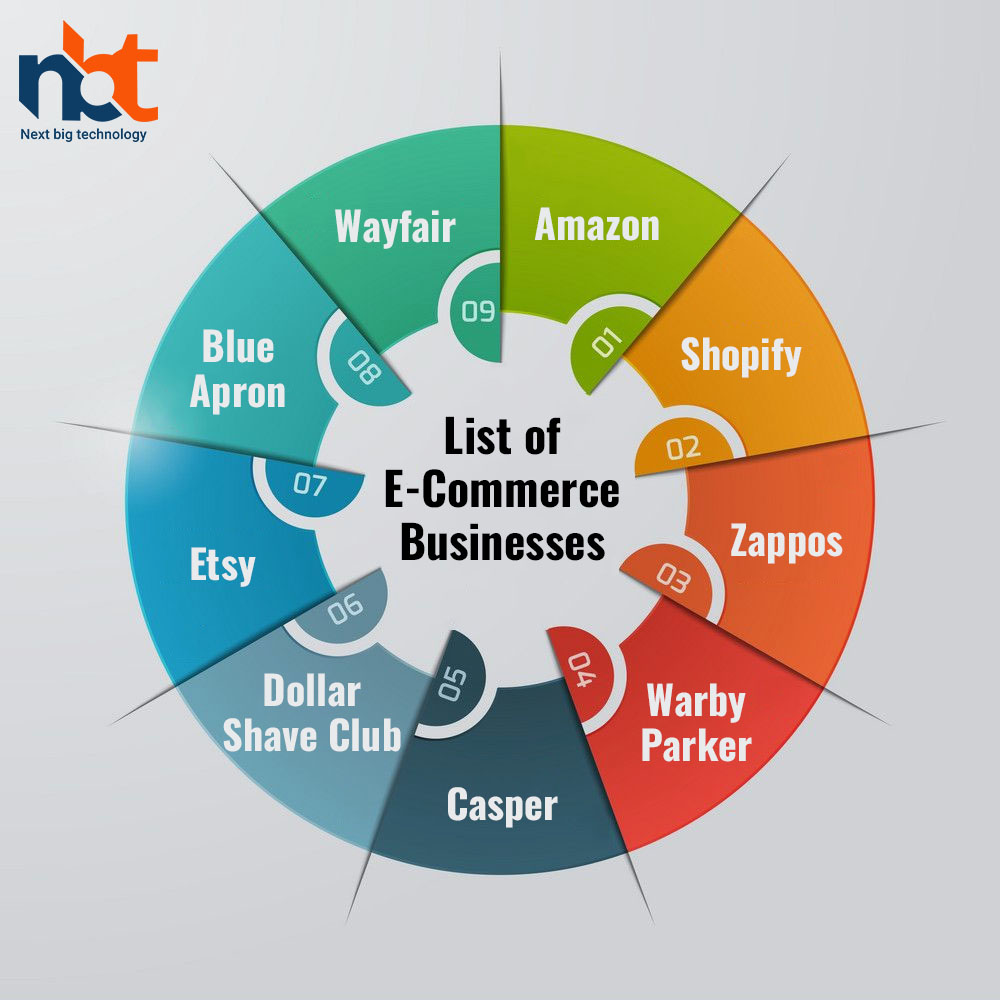Table of Contents
Working Of E-Commerce:
E-commerce, short for electronic commerce, is the buying and selling of goods or services over the Internet. It has become an increasingly popular way for businesses to reach a wider audience and for consumers to conveniently shop from the comfort of their own homes. This article will explain how e-commerce works in layperson’s terms. Our post will tell you all about working process of eCommerce website.
Overview of E-commerce
E-commerce includes using electronic gadgets such as computers, smartphones, and tablets to conduct trade exchanges. It includes an assortment of commerce models, counting Business-to-Business (B2B), Business-to-Consumer (B2C), Consumer-to-Consumer (C2C), and Consumer-to-Business (C2B).
B2B e-commerce alludes to business exchanges, such as a producer offering merchandise to a wholesaler. B2C e-commerce includes exchanges between a trade and a customer, such as a client acquiring an item from an internet retailer. C2C e-commerce includes exchanges between customers, such as people offering goods to each other on a commercial web center like eBay. C2B e-commerce alludes to exchanges where buyers offer business merchandise or services, such as an independent essayist advertising their services to a content-promoting office.
We have an essential understanding of the diverse sorts of e-commerce; let’s plunge into how e-commerce works.
Evolution of eCommerce:
The advancement and history of eCommerce can be followed back to the late 1970s when electronic information compatibility (EDI) was presented. EDI was a computer-to-computer trade of trade reports such as buy orders and invoices. This permitted businesses to trade data electronically rather than using paper-based frameworks.
Within the 1980s, the primary electronic-keeping money frameworks were presented, permitting customers to access their bank accounts and conduct exchanges electronically. This was the primary step towards the online shopping involvement we know nowadays.
In 1990, the World Wide Web was designed by Tim Berners-Lee, driven by the introduction of the primary web browser, Netscape Navigator, in 1994. This made it conceivable for businesses to form websites and offer items and services online.
The primary online store, NetMarket, was propelled in 1994, and the primary secure online exchange was conducted in 1995. This permitted clients to create online buys with certainty, knowing that their personal and money-related data was secure.
Within the late 1990s and early 2000s, eCommerce saw a boom with the presentation of online marketplaces such as Amazon and eBay. These stages permitted businesses to reach a more extensive group of onlookers and offer items universally.
The presentation of versatile gadgets, such as smartphones and tablets, within the mid-2000s, too, had a remarkable effect on eCommerce. Mobile commerce (m-commerce) became a better approach for clients to shop online, and businesses had to optimize their websites for portable devices to remain competitive.
The rise of social media in the late 2000s too driven by the presence of social commerce, where businesses could offer items and services specifically through social media stages.
Nowadays, eCommerce proceeds to advance and develop quickly. The presentation of modern advances such as counterfeit insights and virtual reality is changing how clients shop online. Businesses must investigate other ways to improve customer experiences, such as advertising personalized item proposals and same-day delivery.
How E-commerce Works
Online Store Creation
The primary step in e-commerce is the creation of a web store. This includes creating an online site exhibiting the items or services sold. The site must be user-friendly and outwardly engaging in drawing in and holding clients.
Numerous e-commerce stages offer formats and instruments for businesses to set up their online store effortlessly. Illustrations of prevalent e-commerce stages incorporate Shopify, WooCommerce, and Magento.
Item Posting
Once the online store is set up, the other step is listing the items or services sold. This incorporates giving depictions, pictures, and estimating data. To avoid any mistaken assumptions or client complaints, it is critical to guarantee that the item data is precise and up-to-date.
Shopping Cart
The shopping cart may be a virtual cart that permits clients to include items in their arrangement as they browse through the online store. Once they are done shopping, they can continue to checkout and pay for their arrangement.
The shopping cart permits clients to alter their arrangements by evacuating or including things sometime recently finalizing their buy.
Installment Portal
The installment door is the framework that forms the installment for the arrange. This includes safely transmitting the customer’s installment data to the installment processor and authorizing the installment.
Illustrations of installment gateways include PayPal, Stripe, and Square.
Arrange Fulfillment
Once the installation has been handled, the arranged fulfillment preparation starts. This includes picking and pressing the items, producing a shipping name, and shipping the items to the client.
The arranged fulfillment handle can be done in-house or outsourced to a third-party coordination (3PL) supplier.
Client Benefit
Client benefit is a critical viewpoint of e-commerce. It includes tending to client requests, settling issues, and handling returns and discounts.
Numerous e-commerce stages offer instruments and integrations to assist businesses in overseeing their client benefit needs, such as a ticketing framework or chatbot.
Analytics and Optimization
The last step in e-commerce is analyzing and optimizing the online store’s execution. This includes measurements such as site activity, change rates, and client behavior to distinguish regions for advancement.
Businesses can use this information to create educated choices in their promoting procedure, item advertising, and site plan to optimize their e-commerce execution.
Advantages of E-commerce
E-commerce offers many advantages to both businesses and consumers.
For businesses, e-commerce provides a cost-effective way to reach a wider audience, reduce overhead costs, and increase revenue. It also allows flexibility in terms of operating hours and location, as an online store can be accessed by customers from anywhere and at any time. E-commerce also allows businesses to track customer behavior and gather valuable data on their buying habits, which can be used to optimize their marketing strategy and product offerings.
For consumers, e-commerce offers convenience and accessibility. Customers can shop from the comfort of their homes and easily compare products and prices from multiple online stores. E-commerce also offers a wider range of products and services than traditional brick-and-mortar stores, making it easier for consumers to find exactly what they want.
Things Needed for an eCommerce Platform:
- E-commerce offers numerous points of interest to both businesses and buyers.
- For businesses, e-commerce gives a cost-effective way to reach a more extensive gathering of people, diminish overhead costs, and increment income. It also permits adaptability regarding working hours and area, as clients can access an Internet store anywhere and anytime. E-commerce, moreover, offers businesses the capacity to track client behavior and accumulate profitable information on their buying propensities, which can be utilized to optimize their promoting technique and item offerings.
- For buyers, e-commerce offers comfort and openness. Clients can shop from the consolation of their possessions and effortlessly compare items and costs from different online stores. E-commerce, moreover, offers a more extensive range of items and services than conventional brick-and-mortar stores, making it less demanding for buyers to find exactly what they are seeking.
Also Read : 10 methods to Make Your Ecommerce Website More User-Friendly
Things Required for an eCommerce Stage:
An e-commerce framework may be a. complex arrangement of equipment, program, and forms that work together to encourage online exchanges between businesses and clients. To form an effective e-commerce framework, a few basic components must be input. These components incorporate:
- Site or online store: An e-commerce site or online store is the essential component of an e-commerce framework. It is the stage where clients can browse, explore for, and buy items and services. The site should be simple to navigate, outwardly engaging, and have all the vital data, almost the items or services being sold.
- Item catalog: An item catalog may be a database of all the items or services the commerce advertises. It should contain item portrayals, costs, pictures, and other important information that customers get to make educated acquiring choices.
- Shopping cart: A shopping cart may be an include that permits clients to choose and store things they wish to buy. Clients can include or evacuate items from the cart and see the overall fetched of their buy time recently checkout.
- Payment door: An installment door is a secure framework that permits clients to form online installments utilizing credit cards, charge cards, or other installment strategies. The installment portal should be simple, secure, and offer different installment choices.
- Arrange service framework: An arranged service framework may be a program that makes a difference when businesses oversee their orders from beginning to wrap-up. It should incorporate stock service, arranged preparation, shipping and following, and client bolster.
- Client database: A client database records all client data, counting names, addresses, e-mail addresses, and buy history. It can be utilized to personalize promoting campaigns and progress the client encounter.
- Analytics and announcing: Analytics and detailing apparatuses allow businesses to track client behavior, degree the victory of promoting campaigns, and recognize ranges for advancement within the e-commerce framework
Also Read : Top Business Models that Works for Online eCommerce Websites
Designing an E-Commerce Website:
Planning an e-commerce site includes carefully arranging and considering a few key variables. Here are the basic steps to planning an e-commerce site:
- Decide your target gathering of people: The primary step in planning an e-commerce site is to get your target people. Decide their demographics, interests, and preferences to form a website that caters to their needs.
- Select a suitable stage: Selecting an appropriate e-commerce stage is pivotal for the victory of your site. Select a user-friendly, customizable stage that offers all the highlights you wish to oversee your online store.
- Create a location structure: A well-organized structure is basic for a user-friendly e-commerce site. Create a clear progression of pages and categories that are easy to explore.
- Plan an outwardly engaging format: The plan of your e-commerce site ought to be outwardly engaging and reliable, along with your brand picture. Utilize colors, typography, and pictures that reflect your brand character and appeal to your target gathering of people.
- Optimize for versatile gadgets: A critical rate of online shopping is done through portable gadgets. Guarantee your e-commerce site is optimized for portable gadgets to supply consistent client involvement.
- Make an automatic route framework: An instinctive route framework makes a difference in clients discovering what they are seeking rapidly and effectively. Utilize clear names, drop-down menus, and breadcrumbs to direct clients through your site.
- Center on product pages: Item pages are the most basic component of an e-commerce site. Incorporate high-quality pictures, detailed product portrayals, estimating data, and client surveys to assist customers in making informed obtaining choices.
- Execute a secure payment portal: Clients must feel secure when making online installments. Actualize a secure installment portal that acknowledges numerous installment alternatives and provides consistent checkout involvement.
- Test and optimize: Testing and optimizing your e-commerce website is a progressing handle. Utilize analytics devices to track user behavior, distinguish regions for change, and optimize your site to supply distant better; a much better; a higher; a stronger; and improved client experience.
Also Read : The Main Principles Used When Developing an Ecommerce Website
Challenges of E-commerce
Whereas e-commerce offers numerous benefits, it also comes with its own challenges.
One of the greatest challenges of e-commerce is competition. With numerous such businesses offering items and services online, it can be troublesome for a new trade to stand out and pull in clients. Businesses must contribute to promoting and publicizing endeavors to construct brand mindfulness and drive activity to their online store.
Another challenge of e-commerce is security. As e-commerce includes transmitting delicate data such as installment points of interest, it is critical to guarantee that the online store is secure and protected from cyber assaults. Businesses must contribute to security measures such as SSL certificates and firewalls to ensure their customers’ data.
Finally, e-commerce requires businesses to have productive coordination and arrange fulfillment forms. This includes planning with shipping carriers, overseeing stock levels, and guaranteeing opportune conveyance of orders. Businesses must contribute to a dependable and productive arrangement fulfillment framework to guarantee that orders are conveyed precisely and on time.
List of E-Commerce Businesses:
E-commerce businesses come in numerous shapes and sizes, and there are various illustrations of effective e-commerce businesses in different businesses. Here are several cases of e-commerce businesses:
- Amazon: Amazon is one of the biggest e-commerce businesses in the world, advertising a wide range of items and services, counting books, hardware, clothing, and gushing services.
- Shopify : Shopify is an e-commerce stage that permits businesses to make online stores and offer items and services. It offers a range of highlights, including counting site plans, payment processing, and stock service.
- Zappos: Zappos is an internet shoe and clothing store that gives a wide determination of items and free shipping and returns. It is known for its client benefit and encompasses a faithful taking after of clients.
- Warby Parker: Warby Parker is an e-commerce trade that offers eyeglasses and shades online. It offers an interesting try-before-you-buy program that permits clients to undertake glasses at home sometime recently.
- Casper: Casper is an e-commerce commerce that offers sleeping pads online. It offers a run of sleeping pads and bedding items and contains a customer-friendly return approach.
- Dollar Shave Club: Dollar Shave Club is an e-commerce exchange that gives razors and other prepping things online. It offers an enrollment advantage, which passes on items to customers’ homes.
- Etsy: Etsy may be a commercial web center that permits people to offer carefully assembled and vintage things. It highlights a reliable take after of buyers and merchants and offers a great shopping involvement.
- Blue Apron: Blue Apron is e-commerce commerce that passes on supper units directly to customers’ homes. It expands supper choices and joins a center on maintainability and adjacent sourcing.
- Wayfair: Wayfair is an e-commerce commerce that provides furniture and residential stock online. It offers a wide choice of things and highlights a center on sensible assessing and client advantage.
Conclusion
E-commerce has revolutionized the way businesses and customers conduct exchanges. By leveraging the control of the web, businesses can reach a more extensive group of onlookers, decrease costs, and increment income. For customers, e-commerce offers comfort, openness, and a more extensive extent of items and services.
Whereas e-commerce offers numerous benefits, it also comes with its own challenges. Businesses must contribute to showcasing and promoting endeavors, execute security measures to secure client data, coordinate proficiently, and arrange fulfillment forms.
By and large, e-commerce could be a quickly developing industry with numerous openings for businesses and customers. As innovation proceeds to progress, e-commerce will proceed to advance and change the way we conduct exchanges online.
Thanks for reading our post “Working process of eCommerce website”. Please connect with us to know more about eCommerce Development.













